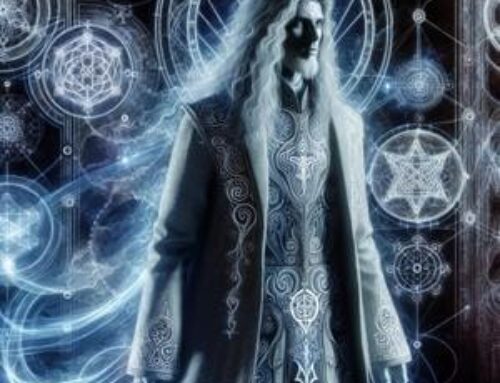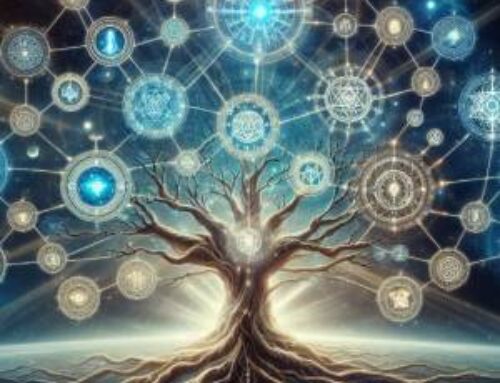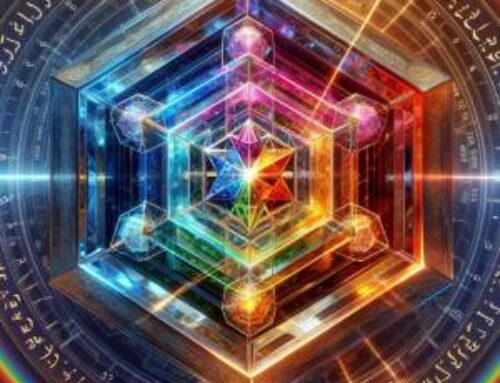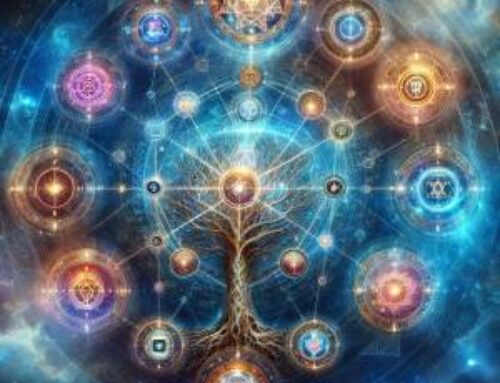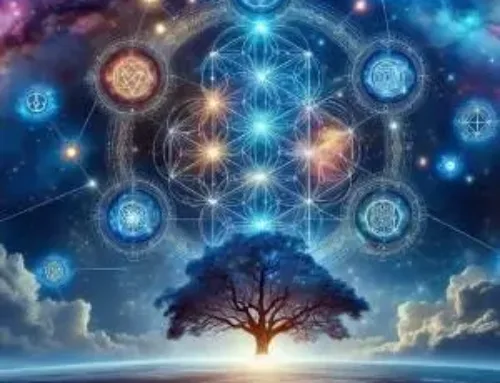Contents
Introduction to Alchemy and Kabbalah
In the crucible of alchemy lies the quest for the Philosopher’s Stone, a symbol not merely of material transmutation from lead into gold, but of the soul’s journey towards purity and enlightenment. Parallelly, the Kabbalah, with its intricate study of the Ain Soph and the dynamic Tree of Life, offers a map of the cosmos and the soul, guiding seekers through the emanations of the Divine to return to the ultimate source, the unfathomable infinity.
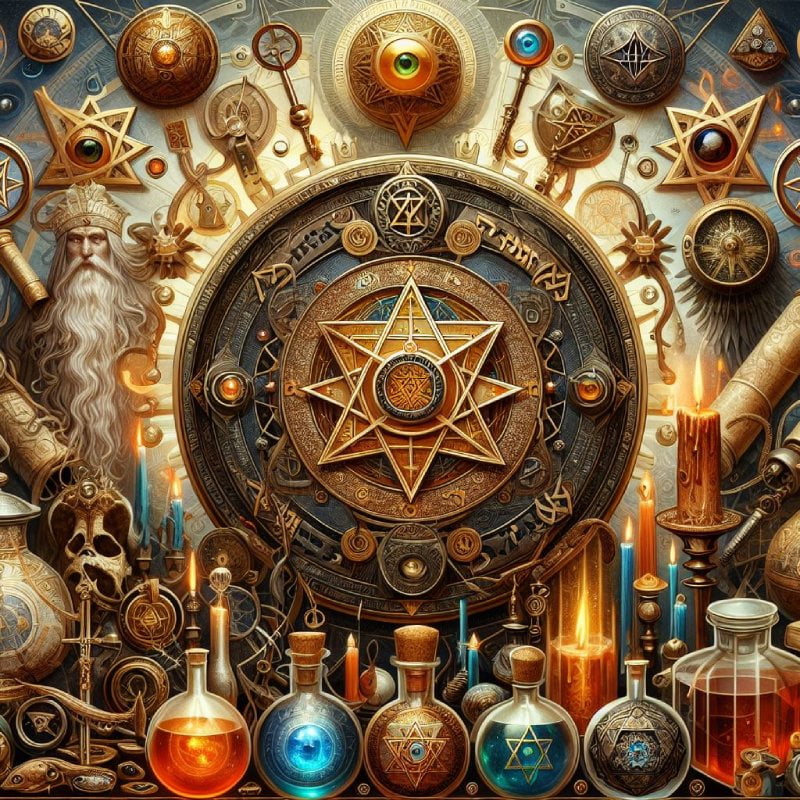
This article seeks to unravel these complex yet fascinating systems of thought and practice. At their core, both traditions are united in their pursuit of knowledge and transformation, aiming not just for an understanding of the universe’s workings but for a profound, intimate union with the Divine. It is a path steeped in symbols, allegories, and rituals, each element a rung on the ladder to spiritual ascension.
As we delve into the historical roots, the symbolic language, and the transformative processes of alchemy and Kabbalah, we discover their relevance to modern seekers of wisdom. These ancient teachings, far from being relics of the past, are beacons of light illuminating the path to self-discovery and divine communion. They challenge us to look beyond the veil of the material, to refine our essence, and to embrace the mystical union that lies at the heart of all creation.
In this exploration, we aim not just to inform but to inspire—a call to embark on the ultimate journey of transformation. Through the lens of alchemy and Kabbalah, we are invited to witness the alchemical marriage of wisdom and spirit, leading us towards the gold of inner enlightenment and the realization of our true, boundless nature.
The Foundations of Alchemy and Kabbalah
Historical Roots and Philosophical Underpinnings
At the heart of our quest for spiritual understanding lie the ancient practices of alchemy and Kabbalah, each a testament to humanity’s enduring search for the divine (e.g. 1).
Alchemy, often perceived through the lens of its chemical endeavors, is fundamentally a spiritual tradition. Its origins, shrouded in the mists of time, stretch back to ancient Egypt and Hellenistic Greece, where the fusion of practical chemistry and mysticism birthed a quest not just for physical transformation but for spiritual enlightenment. The alchemist seeks the Philosopher’s Stone, symbolizing the ultimate material and spiritual transformation.
The Inner Transformation
Alchemy transcends mere metalwork. Its true goal is the transformation of the alchemist’s soul from a state of base ignorance to spiritual enlightenment. This journey is encoded in the alchemical process of turning lead into gold, a metaphor for the soul’s progression from darkness to divine light. Alchemists, through their arcane texts and symbolic imagery, invite us into a realm where every substance and every process mirrors the profound transformations within (2).
Spiritual intelligence, a type of intelligence, can be developed independently through multiple ways of knowing and integrating inner and outer life, leading to wisdom and compassionate action in the world.
The Mystical Map of the Universe
Parallel to the alchemical journey, Kabbalah emerged as a profound mystical and philosophical tradition within Judaism. With roots that scholars trace to the 12th century, though its origins are likely far older, Kabbalah provides a mystical framework to understand the nature of God, the universe, and the soul. Central to Kabbalistic thought is the Tree of Life, a symbolic representation of the divine emanations through which the Infinite interacts with the physical world (3).
The Interconnection of All
While alchemy and Kabbalah may appear distinct, at their core, they share a common thread: the belief in the interconnectedness of all things, both material and spiritual. This principle underpins the alchemist’s work with substances and the Kabbalist’s meditation on the Sephiroth of the Tree of Life. Both traditions teach that by understanding these connections, one can approach the divine, achieve enlightenment, and even affect change in the physical realm.
A Legacy of Wisdom
The foundational principles of alchemy and Kabbalah have left an indelible mark on the tapestry of spiritual and philosophical thought. By exploring these roots, we not only uncover the historical significance of these traditions but also their relevance to contemporary seekers of wisdom. They remind us that the journey toward enlightenment is both an inward quest and a transformation that mirrors the alchemical process, leading us from ignorance to illumination, from the leaden weight of our limitations to the golden light of understanding.
The Prima Materia and the Ain Soph
The journey of alchemy begins with the Prima Materia, or the First Matter, a concept representing the original, undifferentiated substance from which all matter is believed to be derived. This arcane concept is not merely a physical entity but a profound metaphor for the raw, unrefined aspects of the self that the alchemist seeks to transform. The Prima Materia is the starting point, the chaos or void, mirroring the state of the soul before the initiation of its spiritual journey. It embodies potentiality, the seed from which the spiritual gold — enlightenment and perfection — can be actualized through the alchemical process.
The Kabbalistic Infinite: Ain Soph
In Kabbalah, the beginning of the spiritual journey is symbolized by the Ain Soph, the Infinite or Endless One, representing the boundless aspect of God prior to self-manifestation. The Ain Soph is beyond comprehension, without limit or form, existing before the emanation of the universe. This concept underscores the idea that the Divine Source is omnipresent yet transcendent, immanent in all yet beyond all. The Kabbalistic path involves traversing the Sephiroth on the Tree of Life, moving from the manifest back to the unmanifest, from creation back to the source, the Ain Soph.
Parallel Paths of Creation and Transformation
Both alchemy and Kabbalah articulate a journey from an initial state of undifferentiated unity (Prima Materia or Ain Soph) through a process of differentiation, development, and refinement back to a state of perfected unity. In alchemy, this is the magnum opus — the great work of turning lead into gold. In Kabbalah, it is the mystical ascent through the Sephiroth, seeking reunification with the Ain Soph. These paths, though articulated differently, are parallel journeys of transformation and enlightenment. They remind us that the spiritual quest is one of returning to our primordial, divine essence, having transformed the base elements of our existence into something pure, enlightened, and divine.
The Role of the Seeker
In both traditions, the seeker plays an active role in this process of transformation. The alchemist must labor in the laboratory, employing both physical and spiritual techniques to effect the transmutation. Similarly, the Kabbalist engages in study, meditation, rituals, initiations, and ethical living as means to ascend the Tree of Life. The seeker’s intention, dedication, and inner work are pivotal, highlighting the principle that spiritual enlightenment is not a passive inheritance but a hard-won achievement, requiring diligence, insight, and the courage to confront and transform one’s innermost self.
Unveiling the Mysteries
The concepts of Prima Materia and Ain Soph serve as gateways into the profound spiritual landscapes of alchemy and Kabbalah. They invite us to contemplate the origins of existence, the nature of the divine, and our place within this cosmic framework. As we delve deeper into these mysteries, we uncover layers of meaning that inform our journey towards spiritual enlightenment, guiding us through the labyrinth of our own consciousness towards the luminous heart of the divine.
The Magnum Opus and the Tree of Life
The alchemical magnum opus, or great work, is the process through which the Prima Materia is transformed into the Philosopher’s Stone, a symbol of ultimate knowledge and divine enlightenment. This journey is not merely one of converting base metals into gold but is deeply symbolic of the alchemist’s personal transformation and spiritual awakening. The stages of the magnum opus—nigredo (blackening), albedo (whitening), and rubedo (reddening)—represent successive phases of purifying the soul, achieving enlightenment, and ultimately attaining a state of divine unity and unconditional love. Each stage is fraught with challenges yet is essential for the seeker’s evolution.
Ascending the Tree of Life
In parallel, the Kabbalistic journey involves ascending the Tree of Life, a symbolic map of the universe and the human psyche, comprising ten Sephiroth (divine emanations) and twenty-two paths. This ascent is a mystical process of self-refinement and spiritual discovery, aiming to return to the Ain Soph, the source of all creation. Each Sephirah embodies specific divine attributes and aspects of human experience, offering unique lessons and insights. The seeker’s path weaves through these emanations, integrating their qualities, balancing the divine light within, and fostering a deep, personal connection with the divine.
The Interplay of Light and Darkness
Both alchemy and Kabbalah recognize the necessity of embracing both light and darkness within the spiritual journey. The nigredo phase and the path through the darker Sephiroth, such as Binah (understanding) and Geburah (severity), challenge the seeker to face their inner darkness, doubts, and fears. These stages are crucial for spiritual growth, emphasizing that enlightenment is not the denial of darkness but its integration and transcendence. The journey is one of wholeness, acknowledging and transforming every aspect of the self.
The Union of Opposites
At the core of both traditions is the mystical union of opposites, a convergence of the spiritual and material, the divine and the mundane, male and female, light and darkness. In alchemy, this is symbolized by the coniunctio oppositorum, the sacred marriage of the king and queen, leading to the creation of the Philosopher’s Stone. In Kabbalah, the harmonious balance and flow between the Sephiroth, such as Chesed (mercy) and Geburah (severity), reflect this union. This dynamic balance is essential for the emergence of Tiphareth (beauty), the Sephirah that symbolizes the heart and the balance of all opposites, mirroring the alchemical gold.
Toward Divine Illumination
The ultimate goal of both the magnum opus and the ascent of the Tree of Life is divine illumination and unity with the universal source. This is not an end but a beginning, a continuous journey of spiritual exploration and contribution to the world. The enlightened seeker becomes a vessel for divine light, embodying wisdom, compassion, and a profound sense of interconnectedness with all creation.
Deciphering the Mystical Language
Alchemy speaks in a language rich in symbols and allegories, a cryptic vocabulary that conceals its secrets from the uninitiated. Each symbol, from the Ouroboros, the snake eating its own tail representing the cyclic nature of the universe, to the Phoenix, symbolizing rebirth and renewal, is a key to understanding deeper spiritual truths. The alchemical process itself, with substances undergoing dissolution, separation, and reunification, mirrors the soul’s journey of disintegration, purification, and eventual unity with the divine. To decipher these symbols is to unlock the wisdom of transformation inherent in the cosmos and within oneself.
Kabbalistic Symbology: The Tree of Life
In Kabbalah, the Tree of Life stands as a monumental symbol, encapsulating the essence of existence, the blueprint of creation, and the path to divine understanding. Each Sepirah on the Tree represents not only an attribute of God but also reflects aspects of the human condition, offering a map for spiritual ascent. The paths between the Sephiroth are adorned with symbolic associations, drawing from the Hebrew alphabet, astrological signs, and Tarot imagery, each a thread in the intricate tapestry of Kabbalistic wisdom. The study and meditation on these symbols serve as a transformative practice, guiding the seeker through the layers of meaning and towards the luminous heart of divine knowledge.
Alchemical Gold and the Shekinah: Divine Presence
At the pinnacle of both alchemical and Kabbalistic traditions is the quest for the ultimate symbol of divine presence and enlightenment. In alchemy, this is the pursuit of the Philosopher’s Stone, or alchemical gold, representing the highest state of spiritual perfection and the realization of one’s divine nature. In Kabbalah, the presence of the divine is embodied in the Shekinah, the indwelling glory of God, which descends to dwell among creation and is especially associated with the Sabbath and the sacredness of marital union. Both symbols invite the seeker to experience the divine not as a distant, abstract force but as an intimate, transformative presence within the fabric of daily life.
The Role of Allegory: Teaching through Stories
Both alchemy and Kabbalah extensively use allegory to convey their teachings, employing narratives that encapsulate spiritual lessons. The alchemical journey of the king and queen through various trials and transformations teaches about the stages of spiritual evolution and the reconciliation of opposites. Kabbalistic texts, like the Zohar, present allegorical stories that encode mystical teachings, inviting contemplation and interpretation. These stories are not mere fables but are profound teachings encoded in narrative form, designed to bypass the rational mind and speak directly to the soul.
The Universality of Symbolic Language
The symbolic language of alchemy and Kabbalah transcends cultural and religious boundaries, tapping into universal archetypes and human experiences. It speaks to the deep, often unconscious aspects of our being, evoking insights and transformations that rational discourse cannot. By engaging with these symbols and allegories, the seeker is invited into a dialogue with the mysteries of existence, embarking on a journey that is both deeply personal and universally resonant.
Implementing the Teachings of Alchemy and Kabbalah
The Art of Transformation
Alchemy’s relevance extends beyond the confines of the laboratory into the fabric of everyday life. Its principles of transformation can be applied to personal growth, healing, and the pursuit of wisdom. Living alchemy involves recognizing the Prima Materia within our lives—those raw, unrefined elements of our existence that require purification and transformation. Through mindfulness, self-reflection, and the disciplined practice of virtues, we engage in the alchemical process, turning the lead of our limitations into the gold of our highest potential. This practice is not just about self-improvement but about realizing a deeper connection with the cosmos and our place within it.
Kabbalah offers profound insights into the structure of the universe and our relationship with the Divine. Its teachings can be applied through meditation, prayer, and the observance of ethical conduct, serving as a guide for navigating the complexities of life. By meditating on the Sephiroth and their connections, we can balance and harmonize the different aspects of our being, from the groundedness of Malkuth (Kingdom) to the expansive spirituality of Kether (Crown). Kabbalah encourages us to see our lives as a microcosm of the divine cosmos, urging us to live with intention, compassion, and a deep sense of interconnectedness.
The Alchemy of Relationships
The alchemical journey is also mirrored in the dynamics of human relationships. The concept of the coniunctio, or sacred marriage, symbolizes the union of opposites within ourselves and with others. In our interactions and relationships, we encounter reflections of our own inner dualities. Through conscious relationship-building—embracing both the challenges and the joys—we engage in a living alchemy that can lead to profound personal and collective transformation. This practice teaches us about love, acceptance, and the alchemical gold of deep, soulful connections.
Living According to the Tree of Life
The ethical teachings of Kabbalah, rooted in the structure of the Tree of Life, provide a framework for living a life aligned with divine principles. Each Sepirah encompasses moral qualities that can guide our actions and decisions. For example, practicing Chesed (Loving-kindness) encourages acts of generosity and compassion, while Geburah (Strength) teaches the importance of setting boundaries and exercising discipline. By embodying these qualities, we bring the divine attributes into the world, fostering a life that is spiritually rich and ethically sound.
Transformative Rituals
Both alchemy and Kabbalah emphasize the importance of rituals as means of engaging with the spiritual realm, such as ceremonial work as taught in initiatory mystery schools. The key is intentionality—approaching these practices with a heart open to transformation and a willingness to encounter the divine mystery. Through these transformative rituals, we not only deepen our understanding of alchemy and Kabbalah but also actively participate in the ongoing creation of the universe, co-creating with the divine.
Conclusion
The exploration of alchemy and Kabbalah unveils a rich tapestry of spiritual wisdom, offering pathways to profound transformation and enlightenment. These ancient traditions, with their deep roots in the mystical interpretation of the universe, invite us into a world where every element of existence is imbued with divine significance. They challenge us to see beyond the material, to engage in the great work of personal and universal transformation.
Alchemy and Kabbalah, in their essence, teach us that the spiritual quest is not a journey outward but inward and upward. It is a voyage of discovering the divine within and around us, of transmuting the base elements of our nature into the gold of spiritual enlightenment. This journey requires patience, perseverance, and a deep commitment to self-exploration and growth. It asks us to embrace the full spectrum of our existence, the light and the darkness, and to find within them the seeds of divine light.
The Fastest Spiritual Path
For those who feel the call of this timeless wisdom, the journey is both a challenge and a promise—a promise of returning to a state of unity with the divine, of living in harmony with the cosmos. The Hermetic Academy stands as a beacon for those seekers, offering guidance, knowledge, and community for those eager to embark on this sacred path. It is a place where the timeless teachings of alchemy and Kabbalah are preserved, studied, and lived, where seekers can find the resources and support to navigate their spiritual journey.
FAQ – Alchemy and Kabbalah
1. What is the primary goal of alchemy and Kabbalah?
The primary goal of both alchemy and Kabbalah is spiritual transformation and enlightenment. Alchemy focuses on the transmutation of the base aspects of the self into a higher, spiritual form, symbolized by the quest for the Philosopher’s Stone. Kabbalah seeks to understand and experience the divine structure of the universe, ultimately aiming for reunification with the divine source, Ain Soph.
2. Can alchemy and Kabbalah be practiced today?
Yes, both alchemy and Kabbalah can be practiced today. Their teachings offer profound insights into spiritual growth, self-awareness, and the nature of the universe, which are timeless and universally applicable. Modern practitioners adapt these timeless wisdom traditions to contemporary life, focusing on personal transformation, ethical living,, rituals, initiations, and meditation.
3. How do alchemy and Kabbalah complement each other?
Alchemy and Kabbalah complement each other in their shared focus on the unity of all things, the transformation of the self, and the quest for divine knowledge. While alchemy uses the metaphor of material transmutation, Kabbalah provides a structured map of the divine emanations. Together, they offer a comprehensive approach to understanding and achieving spiritual enlightenment.
4. What are some practical benefits of studying alchemy and Kabbalah?
Studying alchemy and Kabbalah can enhance personal growth by fostering self-awareness, patience, and resilience. These traditions encourage the development of a balanced and ethical approach to life, improved relationships through understanding of oneself and others, and a deeper sense of connection with the universe.
5. Where can I learn more about alchemy and Kabbalah?
To learn more about alchemy and kabbalah, consider exploring courses and lectures offered by established spiritual schools and organizations, such as the Hermetic Academy, which preserve an authentic hermetic kabbalistic initiatory path.
References:
(1) Glazer, A. (2016). Book Review: Kabbalah: A Neurocognitive Approach to Mystical Experiences. By Shahar Arzy and Moshe Idel. Theological Studies, 77, 979 – 980. https://doi.org/10.1177/0040563916666828r.
(2) Vaughan, F. (2002). What is Spiritual Intelligence?. Journal of Humanistic Psychology, 42, 16 – 33. https://doi.org/10.1177/0022167802422003.
(3) Rubenstein, E. (2020). The Tree of Life: The Kabbalah of Immortality. Hermetic World, Paphos.

